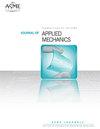利用原子力显微镜和准线性粘弹性模型研究hiPSC-CMs分离的肌原纤维的粘弹性特性
IF 2.8
4区 工程技术
Q2 MECHANICS
引用次数: 1
摘要
了解从人诱导多能干细胞衍生的心肌细胞(hiPSC-CMs)中分离的心肌原纤维的力学特性,可以为了解心肌的结构和功能提供有价值的见解。以往的研究主要集中在使用简化的弹性模型来研究肌纤维刚度。本研究利用原子力显微镜(AFM)测量了从hiPSC-CMs分离的肌原纤维的力学性能。采用准线性粘弹性(QLV)模型来解释肌原纤维的弹性和粘性特性。由于hiPSC-CMs中肌原纤维的粘弹性研究尚未见报道,我们采用猪左心室(LV)组织中肌原纤维的实验工艺和QLV模型参数进行比较和验证。从猪左室组织中提取的肌原纤维弹性模量为8.82±6.09 kPa,这与文献报道猪左室组织的平均硬度低于小鼠和大鼠的结果一致。从hiPSC-CMs中提取的肌原纤维弹性模量为9.78±5.80 kPa,与报道的成人心脏肌原纤维弹性模量为5 ~ 20 kPa的范围一致。我们发现从hiPSC-CMs中分离的肌原纤维比从猪左室组织中提取的肌原纤维弛豫慢,特别是在应力弛豫测试中应力峰值后的前0.25秒。这些发现为hiPSC-CMs的力学行为提供了重要的见解,并对心脏病治疗的发展具有重要意义。本文章由计算机程序翻译,如有差异,请以英文原文为准。
Investigating Viscoelastic Properties of Myofibrils Isolated from hiPSC-CMs Using Atomic Force Microscopy and Quasi-Linear Viscoelastic Model
Knowing the mechanical properties of cardiac myofibrils isolated from human induced pluripotent stem cell-derived cardiomyocytes (hiPSC-CMs) can provide valuable insight into the structure and function of the heart muscle. Previous studies focused mostly on studying myofibrillar stiffness using simplified elastic models. In this study, the mechanical properties of myofibrils isolated from hiPSC-CMs were measured using atomic force microscopy (AFM). The Quasi Linear Viscoelastic (QLV) model was used to interpret the elastic and viscous properties of myofibrils. Since there have been no previous studies on the viscoelastic properties of myofibrils extracted from hiPSC-CMs, myofibrils extracted from porcine left-ventricular (LV) tissue were used to compare and verify experimental processes and QLV model parameters. The elastic modulus of myofibrils extracted from porcine LV tissue was determined to be 8.82 ± 6.09 kPa consistent with previous studies which reported that porcine LV tissue is less stiff on average than mouse and rat cardiac myofibrils. The elastic modulus of myofibrils extracted from hiPSC-CMs was found to be 9.78 ± 5.80 kPa, which is consistent with the range of 5 kPa to 20 kPa reported for myofibrils extracted from adult human heart. We found that myofibrils isolated from hiPSC-CMs relax slower than myofibrils extracted from porcine LV tissue, particularly in the first 0.25 seconds after the peak stress in the stress relaxation test. These findings provide important insights into the mechanical behavior of hiPSC-CMs and have implications for the development of treatments for heart disease.
求助全文
通过发布文献求助,成功后即可免费获取论文全文。
去求助
来源期刊
CiteScore
4.80
自引率
3.80%
发文量
95
审稿时长
5.8 months
期刊介绍:
All areas of theoretical and applied mechanics including, but not limited to: Aerodynamics; Aeroelasticity; Biomechanics; Boundary layers; Composite materials; Computational mechanics; Constitutive modeling of materials; Dynamics; Elasticity; Experimental mechanics; Flow and fracture; Heat transport in fluid flows; Hydraulics; Impact; Internal flow; Mechanical properties of materials; Mechanics of shocks; Micromechanics; Nanomechanics; Plasticity; Stress analysis; Structures; Thermodynamics of materials and in flowing fluids; Thermo-mechanics; Turbulence; Vibration; Wave propagation

 求助内容:
求助内容: 应助结果提醒方式:
应助结果提醒方式:


